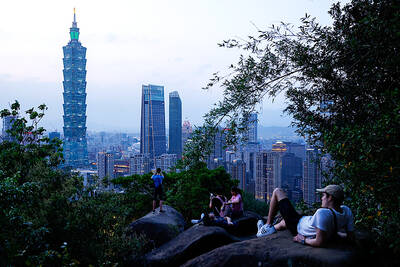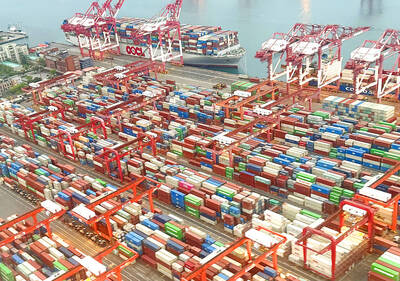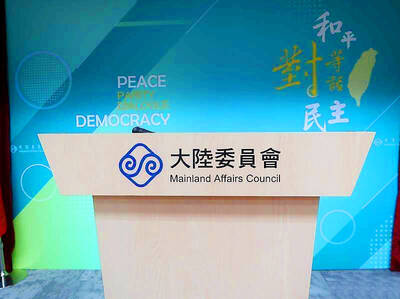In the daytime, the view from Cerro Pachon, a desolate peak high above Chile, offers a breathtaking vista of the Andes. Mountains of rock topped with snow and glaciers seem to touch the heavens.
Come nightfall, the Andes disappear into gloom and then the real show begins. As if someone had flicked a switch, the gleam of millions of planets and stars studs the inky blackness overhead.
The sky seems too immense to absorb, even for giant telescopes. They focus on one tiny portion at a time, pinpricks in the cosmos, because traditionally astronomers like to dwell on detail.
Not any more. Cerro Pachon is to host the Large Synoptic Survey Telescope (LSST), a near US$400 million project that will survey the entire sky several times a week -- something never done before.
Every 15 seconds it will take an image seven times the diameter of the moon, adding up, every three days, to a full panorama of the heavens. Boasting 3,200 megapixels, it will be the world's biggest digital camera.
"Most telescopes look at a tiny part of the sky, to look deep and in detail. We want to look broadly, to cover everything," Victor Krabbendam, the deputy project manager, said on Friday.
Last week the telescope took a step closer to reality, following donations from two geeky billionaires who are entranced by the technology and its possibilities.
Bill Gates gave US$10 million from his fortune and a former Microsoft colleague, Charles Simonyi, gave US$20 million through his Fund for Arts and Sciences.
Gates, one of the world's richest men, said the telescope would turn astronomy into a software issue by writing code and database queries to mine the night sky and recover its secrets.
"LSST is truly an internet telescope which will put terabytes of data each night into the hands of anyone that wants to explore it. [It is] a shared resource for all humanity -- the ultimate network peripheral device to explore the universe," he said.
The donations will keep on track the construction of three large mirrors and three refractive lenses -- the most important and expensive parts of the machine.
The first stages of production for the two largest mirrors are under way at the Mirror Laboratory at the University of Arizona.
Launched in 2000, the project is a partnership based in Tucson, Arizona, and split among 23 universities, laboratories and private entities. Once the mirrors are ready they will be hauled up the 2,690m peak and installed in a dome due for construction in 2011. "First light", as astronomers call their scoping, should begin four years later.
The camera is expected to take more than 200,000 pictures. Processing that information is expected to be the most technically difficult part of the project.
The camera's 15 second exposure should be long enough to capture images of very faint objects such as asteroids and so-called near-Earth objects. By monitoring them night after night, it should be possible to infer their orbit around the sun and hence how likely they are to slam into Earth.
That is how the project's director sold the LSST to congressmen in November.
"The ability to detect virtually every potentially hazardous near-Earth object and determine its orbit with precision transforms that statistical threat into a deterministic prediction," said Anthony Tyson at the University of California, Davis.
But it will also be useful for basic science. Its time-lapse images can be used to create 3D maps of the mass distribution in the universe. That should not only help to trace billions of galaxies, but also tell cosmologists more about the mysterious and recently discovered "dark energy" that is driving the expansion of the universe.
Every night the telescope will pull in 30 terabytes of image data (about 190 times more than a top of the range iPod), which will be made available free on the internet.
"People can find out what's going on everywhere in the sky, and no one has ever done that before -- not even come close," said Donald Sweeney, the project manager. "There are lots of things that happen every night in the sky, and no one has been able to track them and detect them," he said.
Cerro Pachon, located in northern Chile near the city of Vicuna, is a foothill of the Andes, but high enough to escape haze and light pollution. It was chosen over a site in Mexico because it hosts two other telescopes known as Gemini South and SOAR, delivering a ready-made infrastructure.
"It's very beautiful up there, very rocky and quiet. You can see glaciers in the distance," Krabbendam said.
This week's donations will keep the project on schedule by enabling the early fabrication of large optics and other long-lead components of the telescope system, Sweeney said.
Simonyi, estimated to be worth US$1 billion, has an obsession with outer space.
Last year he became the fifth space tourist and the second Hungarian in space.
"There is a similarity between the telescope and these two guys," said Suzanne Jacoby, a project spokesperson. "It's very innovative and the technology is very cool. It appeals to technologically minded people."

MORE VISITORS: The Tourism Administration said that it is seeing positive prospects in its efforts to expand the tourism market in North America and Europe Taiwan has been ranked as the cheapest place in the world to travel to this year, based on a list recommended by NerdWallet. The San Francisco-based personal finance company said that Taiwan topped the list of 16 nations it chose for budget travelers because US tourists do not need visas and travelers can easily have a good meal for less than US$10. A bus ride in Taipei costs just under US$0.50, while subway rides start at US$0.60, the firm said, adding that public transportation in Taiwan is easy to navigate. The firm also called Taiwan a “food lover’s paradise,” citing inexpensive breakfast stalls

TRADE: A mandatory declaration of origin for manufactured goods bound for the US is to take effect on May 7 to block China from exploiting Taiwan’s trade channels All products manufactured in Taiwan and exported to the US must include a signed declaration of origin starting on May 7, the Bureau of Foreign Trade announced yesterday. US President Donald Trump on April 2 imposed a 32 percent tariff on imports from Taiwan, but one week later announced a 90-day pause on its implementation. However, a universal 10 percent tariff was immediately applied to most imports from around the world. On April 12, the Trump administration further exempted computers, smartphones and semiconductors from the new tariffs. In response, President William Lai’s (賴清德) administration has introduced a series of countermeasures to support affected

CROSS-STRAIT: The vast majority of Taiwanese support maintaining the ‘status quo,’ while concern is rising about Beijing’s influence operations More than eight out of 10 Taiwanese reject Beijing’s “one country, two systems” framework for cross-strait relations, according to a survey released by the Mainland Affairs Council (MAC) on Thursday. The MAC’s latest quarterly survey found that 84.4 percent of respondents opposed Beijing’s “one country, two systems” formula for handling cross-strait relations — a figure consistent with past polling. Over the past three years, opposition to the framework has remained high, ranging from a low of 83.6 percent in April 2023 to a peak of 89.6 percent in April last year. In the most recent poll, 82.5 percent also rejected China’s

PLUGGING HOLES: The amendments would bring the legislation in line with systems found in other countries such as Japan and the US, Legislator Chen Kuan-ting said Democratic Progressive Party (DPP) Legislator Chen Kuan-ting (陳冠廷) has proposed amending national security legislation amid a spate of espionage cases. Potential gaps in security vetting procedures for personnel with access to sensitive information prompted him to propose the amendments, which would introduce changes to Article 14 of the Classified National Security Information Protection Act (國家機密保護法), Chen said yesterday. The proposal, which aims to enhance interagency vetting procedures and reduce the risk of classified information leaks, would establish a comprehensive security clearance system in Taiwan, he said. The amendment would require character and loyalty checks for civil servants and intelligence personnel prior to